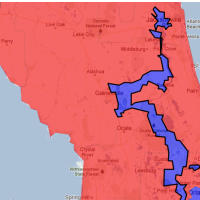Republicans under Pressure as Redistricting Ruled Unconstitutional in Florida and Challenged in Wisconsin
 Florida District 3 (AP graphic)
Florida District 3 (AP graphic)
Republicans took full advantage of their huge state legislative victories in 2010 when they got to redraw election maps after that year’s census. Several states now elect far more Republicans to office than their electorates’ political makeup would suggest.
That may soon change in two states. A challenge of Florida’s map of congressional districts landed in that state’s Supreme Court, and eight of those districts were ordered (pdf) to be redrawn within 100 days. The ruling, on a 5-2 vote, is based on an initiative passed in 2010 by Florida voters that stated that “[n]o apportionment plan or district shall be drawn with the intent to favor or disfavor a political party or an incumbent.”
Florida’s districts were found to have been drawn in secret by Republican legislators with help from GOP operatives. Documents and emails relating to the effort were later found to have been destroyed. “What is clear to me from the evidence…is that this group of Republican political consultants or operatives did in fact conspire to manipulate and influence the redistricting process,” Justice Barbara Pariente wrote for the majority. One district designed to pack in Democratic-leaning voters at the expense of other districts snakes from Orlando more than 100 miles north to Jacksonville.
“We had no idea of the nontransparent and shameful behavior of our legislators,” Pamela Goodman, president of the League of Women Voters of Florida, told The New York Times. “This was the fox guarding the henhouse. In gerrymandered states, lawmakers end up choosing their voters, rather than voters choosing their legislators.”
The state’s Republican-dominated legislature will still be in charge of the election maps, but they could come out giving Democrats a chance to win a few more congressional seats in the 2016 election, according to Patricia Mazzei of the Miami Herald. In addition to the eight districts ordered changed by the court, neighboring districts will be affected as well.
Wisconsin’s gerrymandering of state legislative districts has also been challenged. A suit (pdf) filed in federal court by 12 Democrats charges that the 2011 redistricting is “by any measure, one of the worst partisan gerrymanders in modern American history.”
The suit points out that in 2012, the first year the new districts were used, Republicans captured 60 of 99 legislative races, even though a majority of the votes cast in the election were for Democrats. “This case we hope will be the election law equivalent of Brown v. Board of Education,” attorney Peter Earle told the Milwaukee Journal Sentinel. “We will establish a national standard that can be used reliably into the future.”
Gerrymandering can happen via “cracking” or “packing.” Cracking strips voters of one party from a district and puts them in another where their votes won’t affect the outcome of an election. Packing puts large numbers of a party’s voters in a district so their votes don’t affect other races. The suit charges that the “efficiency gap” of the districts, the number of wasted votes divided by total votes cast, is 13% in Wisconsin, one of the biggest numbers in U.S. history.
-Steve Straehley
To Learn More:
Democrats See Hope in Florida Supreme Court Ruling for New Districts, but Much Remains Unclear (by Patricia Mazzei, Miami Herald)
Florida Court Finds Politics Determined District Lines (by Nick Madigan, New York Times)
League of Women Voters, et. al vs. Ken Detner, et. al (Supreme Court of Florida) (pdf)
Democrats Sue State Election Officials Over 2011 Redistricting (by Patrick Marley, Andrew Hahn and Meg Jones, Milwaukee Journal Sentinel)
William Whitford, et. al vs. Gerald C. Nichol, et. al (U.S. District Court for the Western District of Wisconsin) (pdf)
Florida Judge Slams GOP for Illegal Redistricting (by Noel Brinkerhoff, AllGov)
Florida Labeled Worst Gerrymandered State (by Noel Brinkerhoff, AllGov)
- Top Stories
- Unusual News
- Where is the Money Going?
- Controversies
- U.S. and the World
- Appointments and Resignations
- Latest News
- Trump to Stop Deportations If…
- Trump Denounces World Series
- What If China Invaded the United States?
- Donald Trump Has a Mental Health Problem and It Has a Name
- Trump Goes on Renaming Frenzy






Comments